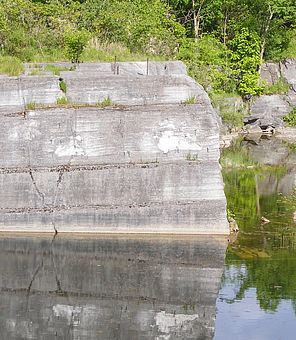The Chazy Reef

Imagine sitting in a lounge chair with your feet in the water looking out over a tropical sea. The sun blazes away and the reefs around you teem with life. There was a time, nearly half a billion years ago, when the area we now call Lake Champlain hosted such an environment. This was before life existed on land, before the bedrock of the region had even formed.
At the time, the continental plate upon which Lake Champlain sits today was located in the lower latitudes of the Southern Hemisphere. Carbon dioxide levels exceeded today’s levels by 14 to 16 percent, and the earth was so warm that practically no ice existed. As a result, sea levels were much higher and the continental shelf was covered by a shallow arm of the Iapetus Ocean. In this arm, some of the world’s earliest reefs developed.
Today, most biotic reefs are formed by coral, but at the time of the original reefs, corals had not yet evolved. The first reef builders were instead small branching organisms called bryozoans. Later in time, large cabbage-like stromatoporoids (related to present-day sea sponges) dominated. Over time, other organisms came to occupy the reefs along with the stromatoporoids including the first corals, though corals never dominated these early reefs. “These structures represent a pivotal moment in the evolution of life on earth, because they are the oldest known, multi-organism constructions on the planet” according to Dr. Robert W. Dalrymple of Queens University in Kingston, Ontario.
Limestone and fossils deposited at the time of the reef building stretch from Tennessee to Newfoundland. However, the fossil evidence is most visible around Lake Champlain where the bedrock’s tilt allows study of many different horizons. Fossils from the period can be seen at many locations around the lake – Valcour Island, Button Bay, Garden Island – but the place to observe the greatest diversity and development over time is Isle La Motte.
Isle La Motte, in the north central part of the lake, was the site of the first European settlement on the lake. The island stretches seven miles north to south and three miles east to west, and about 500 people live there year round. The island hosts two publicly accessible areas ideal for fossil viewing.
The first, the Fisk Quarry, produced distinctive limestone used in many impressive buildings including the Vermont Statehouse, the Brooklyn Bridge, Radio City Music Hall, and the National Gallery in Washington, D.C. It hosts fossils from the middle reef layers including many swirls from early snail-like creatures and fossilized mounds visible in the cut rock.
The second, Goodsell Ridge, hosts the youngest reef layers. Here a north to south walk across the ridge allows one to see millions of years of the reef’s lifespan. Goodsell Ridge has hiking trails that lead to “discovery areas” where interpretive signs sit near exposed areas of bedrock rich in fossils. In addition to the swirls from snails one can see ancient proto-squids. The signs say of them, “They were the predators of the ancient sea, gliding through water, sweeping up other life forms with their tentacles and crushing them with their powerful beaks.”
The fact that these geologic wonders are protected and accessible to the public reflects over a decade of hard work by Linda Fitch and other members of the Isle La Motte Preservation Trust. The group’s efforts were catalyzed in 1995 when a proposal was brought forth to reopen the Fisk Quarry for commercial extraction of limestone. A three-year battle ensued, culminating with the purchase of the quarry by the Preservation Trust in partnership with the Preservation Trust of Vermont. They opened the quarry to the public in 1999. Purchase of Goodsell Ridge followed in 2005 in partnership with the Champlain Land Trust.
In January of 2009, both preserves, along with Valcour Island and Garden Island, were named a National Natural Landmark. National Natural Landmarks are outstanding examples of our country’s biological and geological history. The Department of the Interior manages the program which was founded in 1962. It took eight years of evaluation by scientists, notably Dr. Charlotte Mehrtens at the University of Vermont, before the Isle La Motte preserves earned the designation. Chazy Reef joins a number of other National Natural Landmarks in the Champlain Basin including Little Otter Creek Marsh and Camels Hump.
